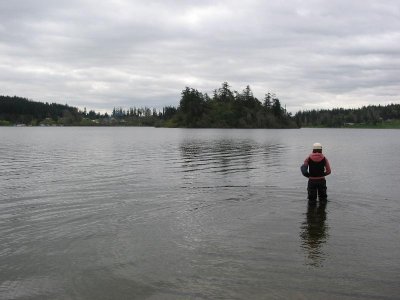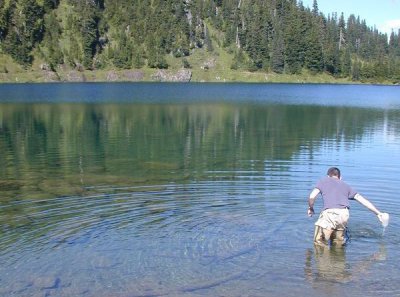Project provides water-quality data for small lakes
Western Washington University Professor of Environmental Science Robin Matthews, director of Western’s Huxley College of the Environment Institute for Watershed Studies, is working with two student volunteers to provide water-quality monitoring data for 70 Washington lakes as part of the institute’s Small Lakes Project.
“We started this project in 2006 as a way of getting student volunteers some top-notch field research experience,” Matthews said. “And it has turned out to not only be just that, but also a very valuable community resource as well.”
Student researchers visit the lakes and collect a series of water samples that are brought back to the institute for testing a series of data points such as dissolved oxygen, phosphorous, turbidity and chlorophyll that together point toward the overall water quality of the lake.
“This water-quality data can be used by scientists, including citizen-scientists, to compare with surface water quality standards listed by the Department of Ecology. For example, if the water temperature is higher than 20 degrees Celcius (or 68 degrees Fahrenheit), it might be too warm even for warm-water fish,” she said. “The chlorophyll and phosphorus values help show whether the lake is likely to have excessive plant growth; if the total phosphorus level is higher than 20 micrograms per liter, the lake has good conditions for developing nuisance or even potentially toxic algae blooms. Finally, with this data you can also compare the water quality in your lake with other lakes in the region.”
Driving all over the northwest corner of the state to take and analyze water samples has been a great way to spend a summer and is excellent field experience, said Western junior Thomas Craig, an Environmental Science major from Roy.
“I’ve really enjoyed this research opportunity. It’s been exciting to finally be able to put the ideas I’ve learned in my classes to practice,” he said.
The data from the Small Lakes Program has proved useful to a number of communities grappling with concerns about water quality. In Bellingham, the People for Lake Padden was formed when users of the popular lake and its surrounding city park became more concerned with the quality of its water, which is used for swimming, fishing, and boating.
Betsy Gross, director of the People for Lake Padden, said Matthews and the Institute for Watershed Studies were indispensable to the success of the group’s citizen initiative to develop a scientifically accurate baseline from which to better protect the lake's water quality and preserve its health.
“Over a two-year period, two interns from Western’s Huxley College regularly collected and analyzed water samples, identifying the lake's algal growth patterns and oxygen levels. Dr. Matthews provided quality assurance, ongoing supervision and use of the IWS lab,” said Gross.
“In the process, she also gave two students valuable experience and the community an increased knowledge about its favorite park's beautiful lake,” said Gross. “A detailed final report was distributed to the city, the county, and the Department of Ecology, all of whom were pleased to have this scientifically accurate, reliable baseline data.”
The institute is monitoring 70 lakes in five Washington counties: Whatcom, Skagit, Island, Snohomish and Grant. For a complete list of the lakes, see the institute’s website.
For more information on the Small Lakes Project, contact Robin Matthews at (360) 650-3507 or robin.matthews@wwu.edu.

